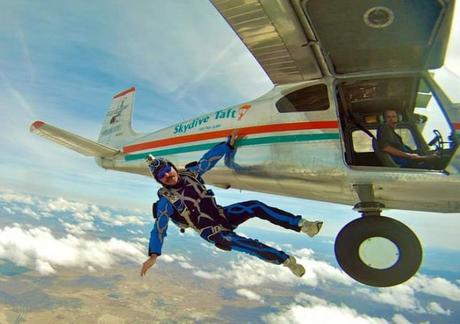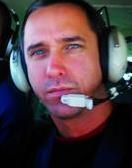How to Properly Fly Skydivers in the Cessna 182
by Chris Rosenfelt

Introduced in 1956 and built in the U.S., France and Argentina, it is by far the most common jump plane in the world. It is the second most common Cessna that is still in production. The average C-182 is powered by the Continental 230hp O-470 engine (models A-R, years 1956-95) and can take 4 skydivers to 10,000ft in about 20 mins. They usually have a modified exit door that swings up like a garage door instead of forward like a car door. They also usually have a small platform or step over the right main landing gear. Operators love the relatively low operating cost and skydivers like the high wing design.
The Numbers
(Models A-R)
Skydiver Capacity: 4 skydivers
Empty Weight: 1610 lbs - 1734 lbs.
Maximum Take Off Weight:
C-182A-D - 2650 lbs.
C-182E-M - 2800 lbs.
C-182N-Q - 2950 lbs.
C-182R - 3100 lbs.
*Many C-182A-M models have been modified with Wing-X wing extensions which increase the MTOW for those models to 2950 lbs.
Useful Load: Varies based on empty wt, gross wt, fuel wt.
Fuel Capacity: 65 gallons (390 lbs) - 80 gallons (480 lbs)
Powerplant: Continental O-470-L, R, S or U (230hp)
TBO: 1500 hrs.
Time to Climb: Approx. 20 mins.
The numbers above are the most common, but there are 23 different Cessna 182 models. Always refer to your aircraft POH for the most accurate information. When you are hired at a drop zone, ask them for their aircraft checklist and for the weight and balance sheet for that specific airplane and ALWAYS verify their numbers. If they do not have checklists or W&B sheets available, download them from our website.
While drinking your coffee in the morning, always check the Aviation Weather site, including the Winds Aloft forecast, and keep checking that throughout the day. When determining your Jump Run direction and distance, don’t forget to convert from AGL to MSL. Also, most jump plane accidents were caused by the pilot not having enough fuel onboard. Stick the tanks before the start of the day and before and after EVERY refueling.
Before Take-Off
Flying skydivers is very challenging and weight and balance is one of the most challenging parts of it. You should already know not to take-off with an airplane that is heavier than its maximum take-off weight limit. Most drop zones want you to fuel for 3 loads, some prefer 2 loads worth plus 30 minutes of reserve during the day.
Cessna 182 jump planes have all of the seats removed except for the pilot’s seat. The arrangement of how the skydivers sit on the floor is dependent on which STC your airplane has, which determines where the seatbelt anchors are located. In ALL types a TI will sit with their back (rig) up against the passenger panel (Always verify that their rig did not get snagged on the lip of the panel etc) with a student between their legs facing the rear of the airplane. In ALL types a TI will be sitting with their back against the back of the pilot’s seat. The variance is where the second student sits. Depending on which STC your airplane has (location of seatbelts), they will either sit facing the rear of the airplane in between the TI’s legs that have their back against the seat or they will sit with their back against the rear bulkhead facing forward.
You will normally have two tandem instructors and two tandem students on every load. Whenever I had a larger than average instructor or student, I had them sit in the most forward slot. Periodically check to make sure that no one has accidentally bumped the fuel tank selector knob.
Every person on-board needs to be seat belted for taxi and take-off. Always keep a hook-knife on you and another stored in the airplane within easy reach. There have been many instances when a skydiver jumped or fell out of the airplane with the seat belt still attached to their leg strap or a part of their rig or suit got caught on the step or main landing gear. If that were to happen, someone, if not you will need to try to cut them free.
A couple more important reminders are to never get caught up in a “rush mode”, that can lead to you forgetting important items on your checklist. Which segues to my next important reminder, ALWAYS double check that the trim is set to “take-off”. I remember, right after I started flying skydivers in 2008 I heard about a C182 jump pilot that forgot to set the trim to “takeoff” from nose-up and right after rotation the airplane nosed up sharply, stalled and crashed. No one survived. AGAIN… DON’T RUSH! READ and DO WHAT’S ON YOUR CHECKLISTS!
Takeoff and Climb
If it’s the first load of the day, be sure and do a run-up and systems check. Add 10 degrees of flaps for takeoff and make sure that your cowl flaps are open. Make the appropriate call on CTAF. Takeoff with full power. Remember that if you lose your engine soon after takeoff and are fully loaded, you are to land straight ahead, do not attempt to turn back to the airport if you are below 500 ft AGL. Climb at 2500 RPM and 25 inches MP, with an airspeed of 85-90 initially.
Check in with ATC as soon as practical. Lower the nose to keep the CHTs below 390. Start leaning between 4000 - 5000 feet. Always stay within gliding distance to the DZ, in case you lose an engine. This can be done by flying a racetrack or spiral climbing pattern, using shallow banking, that gets wider as you climb.
Jump Run
Get to jump altitude about 2 miles before the jump spot. Your settings for jump run should be 15 inches MP, 2200 RPM and 80-85 knots airspeed. (Do NOT flirt with the stall speed! Stalling with skydivers on the step or in the door is one of the worst case scenarios.) Close the cowl flaps. Your jump run direction and length will be determined by the Winds Aloft forecast for your area. Spotting will take some practice, but you will learn it quickly. ATC will usually want you to give them a “2 minutes until jumpers away” call. Also give a “Jumpers away in 1 minute over XYZ airport” call on CTAF.
Depending on what the winds are doing, you will call “Door” at the appropriate time. Remember that they require some time to get into position to jump and even longer if they have a nervous student jumper. Also, when calculating your jump run direction and distance, remember to give more “weight” or consideration for the wind direction and speeds at altitudes when the skydivers will be under canopy, because they will be at those altitudes longer and sometimes the canopy can act as a sail if the wind is strong enough. Most TI’s deploy around 5000 Feet, Fun Jumpers around 3000 feet and Student Skydivers much higher.
You will notice that the airplane will require a lot of left aileron because of the weight shift and drag caused by the skydivers being outside of the airplane on the step and/or hanging onto the wing strut.
Descent
We Jump Pilots are basically doing an emergency descent on every flight. As soon as the skydivers drop away, it’s neutral control wheel and full left rudder to get the door to drop down enough for you to grab and latch it. Tell ATC, "Jumpers away" and make a “Skydivers over XYZ airport 10,000 feet and below” call, while simultaneously raising the wing flaps, closing the cowl flaps and adding carb heat.
Your engine settings should be the same on descent, 15 inches MP and 2200 RPM. Put the airplane in a left bank, keep an eye on the skydivers as long as you can to see if anyone deployed high. If they did, ATC needs to know this information so that they can keep air traffic above that altitude. Also, keep your circle wide in case you did not see that someone deployed their parachute high.
Keep the airspeed within the yellow arc only if in smooth air. As you get lower and closer to the airfield, turn your landing light on and keep your eyes on the skydivers while scanning for other traffic, especially if it is a very windy day and/or you had an AFF (Accelerated Free Fall) skydiver on that load. I’ve had them float across my final or land right on my touchdown zone MANY times. Continuously scan for skydivers from the beginning of descent until parking. Do not fly near the skydiver's landing pattern. Also, don't forget to tell ATC, "Jumpers on the ground", they usually appreciate that. Do them favors whenever you can, they help us every single day and I believe that most pilots take them for granted.
In Conclusion
If you are a newly hired Jump Pilot, get familiar with the FARs that govern skydiving, you will find them listed on our Resources page. Ask your DZO if they have a Training Syllabus, if they do not, you can find that as well on our Resources Page. While on that page, be sure and watch the video "Flying for Skydiving Operations". Also, be sure and join our Jump Pilot group on Facebook here. It's another great resource. Finally, if you have ANY questions at all feel free to email us. We love helping our fellow pilots. Like I always say, Remember to… Never Stop Learning, Review Often and Fly Safe, so that you can continue to… Have Fun!SkydiverDriver.com

